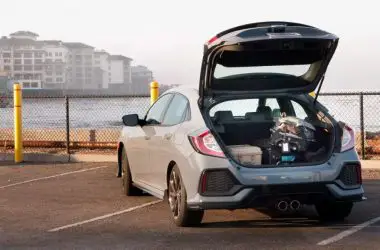Fuel efficiency and fuel economy are related but different measures of how far a vehicle can travel on a certain amount of fuel. Fuel efficiency refers to the amount of work done per unit of fuel, while fuel economy refers to the distance traveled per unit of fuel. In other words, fuel efficiency measures how well an engine converts fuel into motion, while fuel economy measures how far a vehicle can go on a gallon of fuel. Both metrics are important for understanding a vehicle’s performance and helping consumers choose efficient models. However, they differ in how they are calculated and the factors that influence them. This article will explore the key differences between fuel efficiency and fuel economy, how they are measured, what impacts them, and why the two metrics can vary.
Definitions
Fuel efficiency and fuel economy are two related but distinct measures of how far a vehicle can travel per unit of fuel. While often used interchangeably, there are important differences between the terms.
Fuel Efficiency
Fuel efficiency refers to the amount of work done per unit of fuel consumed. For vehicles, it measures how far a vehicle can travel on a gallon or liter of fuel. Fuel efficiency depends on the vehicle’s engine, transmission, weight, aerodynamics, and other mechanical factors. It is expressed in miles per gallon (MPG) in the U.S. and liters per 100 kilometers (L/100 km) in most other countries.
Fuel Economy
Fuel economy refers to the fuel efficiency estimate published by the U.S. Environmental Protection Agency (EPA) to help consumers compare vehicles. Fuel economy ratings represent a vehicle’s expected fuel efficiency during a combination of city and highway driving. The EPA calculates these estimates from controlled laboratory tests. Fuel economy is also expressed in MPG.
While closely related, fuel efficiency describes a vehicle’s mechanical capability while fuel economy reflects an EPA estimate for comparison. Fuel efficiency depends on driving style and conditions, while fuel economy is a fixed rating for each vehicle.
How They Are Measured
Fuel efficiency and fuel economy are related but different metrics for measuring a vehicle’s fuel usage. Both use miles per gallon (MPG) as the main unit of measurement, but how that MPG figure is determined differs between the two.
Fuel efficiency measures how far a vehicle can travel on a gallon of fuel in ideal conditions. It is determined using a dynamometer under controlled laboratory testing. This allows tests to be standardized across all vehicles and isolates the vehicle’s engineering from external factors. As the EPA explains, this laboratory testing focuses purely on the vehicle’s fuel efficiency capability by controlling variables like wind, terrain, weather, and driving behavior.
Fuel economy, on the other hand, estimates on-road MPG during real-world driving. The EPA provides fuel economy ratings for vehicles which aim to reflect a combination of city and highway driving. However, factors like terrain, weather, driving style, vehicle maintenance and accessories can cause real-world results to differ from EPA estimates. Fuel economy aims to provide drivers with a reasonable expectation of their average MPG, while fuel efficiency provides a maximum MPG potential.
Factors That Affect Fuel Efficiency
There are many factors that can impact a vehicle’s fuel efficiency. Some key factors include:
-
Vehicle size and weight – Heavier and larger vehicles require more energy to accelerate and move, which reduces fuel efficiency. Large trucks and SUVs tend to have lower fuel efficiency than smaller sedans and compacts (Source).
-
Engine size – Vehicles with larger engines generally consume more fuel. This is because larger engines need to burn more fuel to generate power (Source).
-
Aerodynamics – The shape and design of the vehicle impacts wind resistance and drag. More aerodynamic vehicle shapes allow air to flow smoothly over the vehicle, improving efficiency (Source).
-
Tire inflation – Properly inflated tires decrease rolling resistance, allowing the engine to work more efficiently and improving fuel economy (Source).
Other factors like transmission type, drivetrain, and vehicle accessories can also impact efficiency.
Factors That Affect Fuel Economy
There are many driving habits and vehicle factors that can affect fuel economy. According to the EPA, aggressive driving such as rapid acceleration and braking can lower gas mileage by up to 33% on the highway and 5% around town (Many Factors Affect MPG). Maintaining a steady speed and avoiding excessive braking are ways to improve fuel efficiency. Driving at lower speeds improves mileage significantly. Every 5 mph over 50 mph decreases fuel economy by 7% (Want Your MPG? 10 Factors That Affect Fuel Economy).
The terrain and type of roads also impact fuel economy. Hilly roads, heavy traffic, unpaved or rough roads can all reduce efficiency. Vehicle weight is another factor. Removing unnecessary cargo improves mileage, as does proper tire inflation. Air conditioning can reduce fuel economy by 10-25% under hot weather driving conditions (Your Mileage May Vary). Overall, adjusting driving habits to be more moderate can significantly improve a vehicle’s fuel economy.
Why the Metrics Differ
Fuel efficiency and fuel economy use different metrics because they measure different things. Fuel efficiency measures how well a vehicle’s engine converts fuel into mechanical power or work (https://engineering.mit.edu/engage/ask-an-engineer/whats-the-difference-between-fuel-efficiency-and-fuel-economy/). The most common measure for fuel efficiency is miles per gallon (MPG). This tells you how many miles a vehicle can travel on one gallon of fuel based on the efficiency of its engine.
Fuel economy, on the other hand, measures how far a vehicle can travel with a certain amount of fuel under specific driving conditions (https://www.endurancewarranty.com/learning-center/terminology/fuel-efficiency-vs-fuel-economy/). In the U.S., this is reported as MPG based on EPA test cycles that simulate different driving scenarios like city driving or highway driving. Fuel economy aims to give consumers a reasonable estimate of a vehicle’s real-world fuel usage under typical driving.
So while fuel efficiency depends solely on the engine and powertrain design, fuel economy relies on testing to replicate actual on-road performance. The EPA fuel economy tests account for additional factors beyond just the engine, like aerodynamics, weight, accessories, and transmission. This results in the two metrics differing in their MPG values.
Fuel Efficiency Standards
The United States government has implemented fuel efficiency standards to regulate the fuel economy of certain vehicle classes. The most well-known standard is the Corporate Average Fuel Economy (CAFE) program, which was first enacted by Congress in 1975 in response to the 1973 oil crisis. The CAFE standards set fleet-wide average fuel economy targets that manufacturers must comply with for their passenger vehicles and light trucks.
The National Highway Traffic Safety Administration (NHTSA) manages the CAFE program. NHTSA establishes the standards for each model year, gradually increasing the targets over time to improve fuel efficiency across the entire U.S. vehicle fleet. The CAFE standards have become more stringent over the decades. For example, the target for passenger cars in 1978 was 18 mpg, compared to 38.3 mpg for the 2021 model year. In August 2021, NHTSA finalized more ambitious CAFE standards for model years 2024-2026, aiming to achieve a fleet-wide average of 40 mpg for passenger cars and light trucks by 2026.
The CAFE program has contributed to significant improvements in fuel economy for new vehicles sold in the United States. However, there is still progress to be made. NHTSA projects that the current standards will increase new vehicle fuel efficiency by 1.5% per year on average between model years 2017 and 2021. Environmental groups argue that faster annual increases of 5% are feasible with existing technologies.
Fuel Economy Estimates
The EPA (Environmental Protection Agency) conducts fuel economy tests and provides the fuel economy estimates commonly seen for new vehicles. These estimates, like “22 city / 30 highway,” are based on standardized laboratory tests conducted under controlled conditions.
Vehicles are tested on dynamometers or “rolling road” devices that simulate different driving cycles like city traffic or steady highway cruising [1]. These tests consist of different speed profiles that represent common driving scenarios. For example, the “city” test involves more stop-and-go driving while the “highway” test simulates steady-state cruising [2].
The EPA city estimate comes from a combination of two driving cycles – one simulating stop-and-go city driving and one more highway-focused. The highway estimate is based on a steadier high-speed cycle [3]. Vehicles are tested at speeds up to 80 mph to calculate highway mpg [2].
The EPA estimates provide a standardized way to compare the fuel economy of different vehicles. However, real-world mileage can vary substantially based on driving conditions and habits.
Improving Fuel Efficiency and Economy
There are several tips that consumers can follow to improve both fuel efficiency and fuel economy of their vehicles:
Regular maintenance like oil changes, air filter replacements, tire rotations, and tune-ups helps the engine perform optimally and improves fuel efficiency (Source 1). Properly inflated tires also reduce friction and rolling resistance, enhancing fuel economy (Source 2).
Driving style significantly impacts fuel efficiency and economy. Aggressive driving with rapid acceleration and braking lowers both. Smooth and gradual accelerations, coasting to stops, and maintaining consistent speeds optimizes these metrics (Source 3). Removing extra weight and roof racks reduces aerodynamic drag and fuel consumption when not needed.
Using the right motor oil grade, keeping up with service schedules, and using fuel additives like detergents can keep the engine running efficiently and enhance fuel economy over time (Source 2). Finally, replacing an older vehicle with a newer, more fuel efficient model can lead to considerable savings at the pump.
The Future of Fuel Efficiency
The future of fuel efficiency looks bright thanks to advancements in technology and alternative fuels. Electric vehicles are becoming increasingly popular and affordable, with longer ranges and faster charging times https://energy5.com/fuel-efficiency-standards-impacts-and-future-regulations. Hybrids, plug-in hybrids, and hydrogen fuel cell vehicles also provide improved efficiency compared to traditional gas engines.
Autonomous vehicle technology is another trend that shows promise, with the potential for connected vehicles to optimize routes and driving habits for maximum efficiency https://energy5.com/achieving-energy-efficiency-in-transportation-innovations-and-trends. Alternative fuels like renewable diesel, biodiesel, and sustainably-sourced biofuels can also reduce lifecycle emissions.
Data analytics and artificial intelligence enable better modeling and simulation to design more aerodynamic, lightweight vehicles and fine-tune engine performance. New materials like carbon fiber composites can reduce weight. Regulations will likely continue pushing for increased efficiency and lower emissions. Overall, technology and innovation point toward major improvements in fuel efficiency across the transportation sector.





